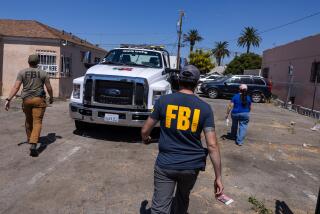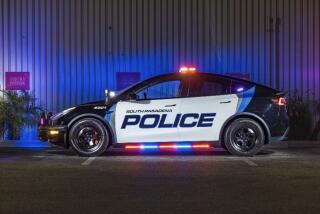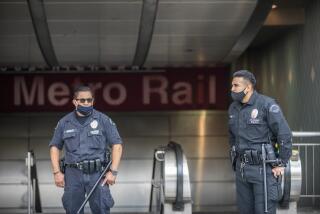Homeland Security and a fast Ferrari
IT’S THE MOST fabulously preposterous L.A. traffic accident since “Crash,” and it just gets better and better. And unlike “Crash” -- in case anyone believes that the movie is a documentary -- it’s true.
A million-dollar red Ferrari, just like one made for the pope, races a Mercedes up PCH in Malibu and crashes into a light pole at 162 mph. Total casualties: One cut lip, on the face of Stefan Eriksson, who insists that he was just a passenger and that the Ferrari’s driver, a German fellow named Dietrich, ran off. The Mercedes sped away too, although investigators suspect that it, along with Dietrich, never existed.
This is all good stuff, but here’s the part I really love: Two guys show up at the scene of the accident flashing badges. They claim Homeland Security status and spirit away Eriksson.
Eriksson turns out to be a suspected Swedish counterfeiter and ex-honcho of a European video game company that crashed almost as spectacularly as the Ferrari. He was waving around a business card declaring him to be a deputy police commissioner of an antiterrorism unit, a title awarded him for technical help to the San Gabriel Valley Transit Authority, which fields a fleet of -- hang on while I get my calculator -- five small buses. The SGVTA operates out of Homer’s Auto Service in Monrovia, doing the laudable and much-needed work of ferrying disabled people to their appointments.
A little shuttle service has an antiterrorism unit? Gentlemen, repeat after me: it’s Al Qaeda, and El Monte.
Sheriff’s deputies, the feds and even Scotland Yard are puzzling all this out. So are Times newsguys Richard Winton and David Pierson. They found the “SGV Transit Authority Police” website (now vanished from the Internet), so puffed up you’d think the unit is a farm team for the LAPD. But the whole “force,” according to Times reporting, consists of at most six and probably three guys, including the owner of the auto repair shop. It’s like a Marx Brothers movie, minus one brother.
The website warns that even a little medical van service can be targeted by evildoers, but not to worry: There’s a “vigilant undercover and overt officer presence” as well as “plainclothes officers and a narcotics detection K-9 team.” Wow -- with that massive police presence, are there any seats left on the bus for passengers?
People have been pretending to be someone else for fun and profit for centuries. One of the most famous restaurants in L.A. was run by a guy who claimed to be a Romanov prince, and everyone went along with it. And how about that perennial L.A. pickup line, “I’m a producer”?
If this antiterrorism transit cop thing is a lot of hype, it’s doubly brilliant, because who could penetrate Homeland Security to check the story?
Then again, if it’s legit, I’ll stop snickering. There’s nothing remotely funny about a climate and a culture in which even someone running a tiny bus service for the disabled need only invoke “antiterrorism” and “homeland security” and “9/11” to become a “freedom-fighter.” Besides the great macho rush, doors open. And so do checkbooks.
Every police agency, every city wants a piece of the action -- and a piece of the dough. With billions of dollars out there virtually for the asking, where’s the line between bold and boondoggle? And who has the guts to say so?
Christopher Cox, the former California Republican congressman who now heads the Securities and Exchange Commission, remarked last year that the Department of Homeland Security sometimes ladled out funding so freely that authorities found themselves “looking for ways to spend the money.” One of his peeved colleagues, a New York Democrat, hammered on preposterous projects that got Homeland Security money -- a paging system for a South Dakota state fair, a customized trailer for a Texas mushroom festival and six figures to teach public-speaking skills to sanitation workers.
In the desert town of Hemet, firefighters got $150,000 of Homeland Security money for computerized communications, but San Diego has been stripped from the list of 35 high-risk metro areas. Hmm ... tunnels under the U.S.-Mexico border, major port, international crossroads -- not a high risk?
All I’m saying is, I won’t be surprised if a check shows up from Homeland Security, made out to the SGVTA antiterrorism unit. Whatever that turns out to be.
*
PATT MORRISON’s e-mail address is patt.morrison@latimes.com.
More to Read
Sign up for Essential California
The most important California stories and recommendations in your inbox every morning.
You may occasionally receive promotional content from the Los Angeles Times.











